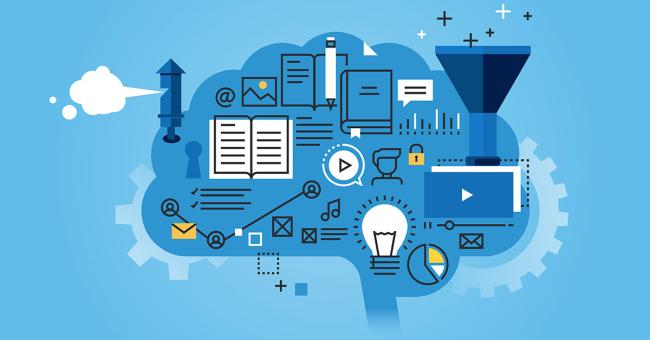3 Ways to Leverage AI and Machine Learning for Training

COVID-19 accelerated a need to change learning and development (L&D) programs and processes quickly. Technology has been a lifeline for L&D during the pandemic. From communication to collaboration to education, the right technology at the right time can streamline and future-proof a company’s learning program even amid a global disruption.
In a recent webinar, Rob Lauber, former Chief Learning Officer at Fortune 500 companies like McDonald’s, YUM! Brands and AT&T and now CEO/founder at XLO Global, LLC, and Doug Stephen, President, Enterprise Learning division at CGS, discuss the L&D technologies and innovations shaping the future of work.
Current State of Learning
To understand where learning is going, we must first take stock of where it is. Not surprisingly, the nature of L&D has shifted to respond to a remote/hybrid workforce. Onboarding, compliance, skills development and other training needs must adapt to this new virtual model. Consider these statistics:
- 77 percent of CEOs in a KPMG survey state they will continue to build on digital collaboration tools to support the future of work
- Only 50 percent of learning teams have a proactive plan for taking on disruptions
- 68 percent of L&D leaders are spending one-quarter or more of their time rethinking and redesigning their programs
- 6 out of 10 learning leaders are planning a monthly/continuous learning cycle
To meet these new challenges in a new world, a host of technologies can be crucial. Machine Learning (ML) is one such technology.
What Is Machine Learning?
According to Nvidia, machine learning is “the practice of using algorithms to parse data, learn from it, and then make a determination or prediction about something in the world.” Stanford suggests that machine learning is “the science of getting computers to act without being explicitly programmed.” Whatever your definition, machine learning is designed to adapt to new data independently and make decisions and recommendations based on thousands of calculations and analyses. In short, machine learning tools enable companies to identify opportunities and risks more quickly.
ML uses statistical models to find patterns in massive amounts of data. For example, imagine you have data on millions of course completions or you have tracked thousands of staff at various stages on a 10-step process. Most useful and cost-effective with massive amounts of data, machine learning can help you understand data, find patterns and drive improvements.
Machine learning comes in three types:
- Supervised: You tell the machine/system what patterns and insights to look for
- Unsupervised: If you don’t know what you are looking for, the algorithm can cull through and find insights and trends you might not have expected
- Reinforcing: You use reinforcing to learn by trial and error to achieve a particular outcome; this is like a continuous improvement algorithm
If efficiently set up and with a large amount of data, machine learning can be very effective. It can show you fine details, such as how long are people watching your videos? What are people doing after completing your course? Who is bringing the training into their work?
Personalizing the Learning Experience
It’s no secret that people have different learning styles. Each employee has preferred learning styles—videos, user guides, in-person training, gamification, etc.—and they will learn most effectively through those methods.
ML allows a training program to adapt to a user; modules are modified to suit each staff member’s needs. Your LMS might offer video tutorials to certain employees, while auto-transcribing the videos to text-based articles for other employees. It could create visuals based on text content or suggest an employee take an alternate type of training on sections of the course on which they are struggling.
Machine learning insights also help you develop a wider understanding of learner behavior, leading to predictive capacities. You can create intelligent and smarter positioned content, that’s adaptive, intuitive, and responsive to a learner’s personal journey.
Significance and Setup
We’ve seen how machine learning can empower and enable your L&D programs, but what about the overall benefits? Many organizations already have a huge amount of data available. Learning staff can use this information to optimize training curricula. ML can benefit your learning program from top to bottom, to include:
- Personalizing learning
- Increasing completion rates
- Shortening learning curves
- Bettering knowledge retention
- Improving accessibility
- Eliminating biases from training
- Upskilling and reskilling
Using the latest technology for L&D is more crucial than ever. According to a University of Georgia study, millennials now rate training and personal development as the number one job benefit, above flexible work hours and cash bonuses. It’s clear that organizations will need to provide the best learning and development to compete in a complex job market. ML can help not only make the learning experience better, but also improve staff performance on the job.
On the setup side, machine learning can be difficult to implement. You need access to the data and a repository to do the algorithms. This is probably done in collaboration with your IT department or a third-party partner.
It can also be expensive, so the larger your amount of data, the better. Smaller amounts of data will make ML seem like an overengineered product.
Yet the investment in machine learning is offset by its many uses. Besides L&D, it can identify and track data across the enterprise. You can use it to find and address issues millions of customers are having with a product or service to streamline help desk support. A more recent example: Agencies can track side effects of vaccines in populations worldwide using these tools.
In the webinar, Doug Stephen offered one example of a customer who used unsupervised learning to improve sales based on the learning patterns of their top performers:
Watch the full webinar now for the entire discussion, as well as some great Q&A at the end around:
- What is your advice on best practices for scaling learning tech and programs globally?
- If you’re new to L&D, what resources are there to explore emerging themes?

